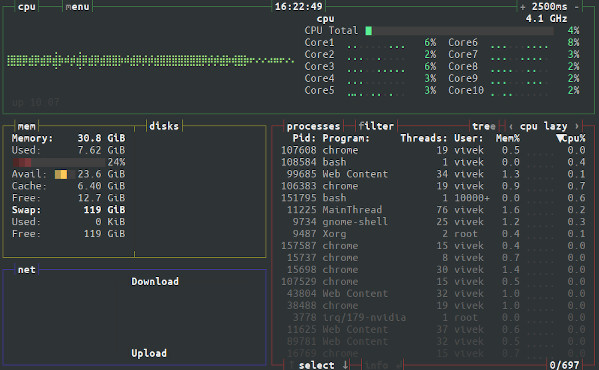There is a new kid in town for resource monitoring on Linux called bashtop. As the name suggests, the entire tool coded in the bash script itself that displays usage and stats for CPU, RAD, HDD/SSD, network, and other resources. Let us see how to install and use bashtop, which is an awesome Linux resource monitor. You don’t need a Linux desktop to install it. You can also install this app on macOS/FreeBSD provided that you meet software requirements.
Installing bashtop – Excellent Linux resource monitor
Installation requirement includes:
- Bash version 4.4+ but Bash version 5.x+ for best performance
- GNU/coreutils
- AWK/sed/grep (all GNU version)
- Python3 and psuti
Let us get our hands on dirty with bashtop.
Ubuntu Linux install bashtop
Run the snap command:$ snap install bashtop
Alternatively, try PPA repository and then install bashtop:$ sudo add-apt-repository ppa:bashtop-monitor/bashtop
$ sudo apt update
$ sudo apt install bashtop
Debian Linux install bashtop
Available in official Debian repository for Debian Linux 11.x only:$ sudo apt install bashtop
FreeBSD install bashtop
You need to install dependencies for FreeBSD using the pkg command:$ sudo pkg install coreutils gsed python3 git
$ sudo python3 -m ensurepip
$ sudo pip3 install psutil
Clone the repo and install it:$ git clone https://github.com/aristocratos/bashtop.git
$ cd bashtop
$ sudo make install
## uninstall command ##
## $ sudo make uninstall
macOS install bashtop
Please note that you need iTerm2 otherwise bastop will not work correctly in the standard terminal shipped with macOS.
Again, install required dependencies for macOS Unix desktop/laptop:$ brew install python3
$ python3 -m pip install psutil
$ brew install bash coreutils gnu-sed git
$ brew install osx-cpu-temp
$ git clone https://github.com/aristocratos/bashtop.git
$ cd bashtop
$ sudo make install
Arch Linux install bashtop
We need use the pacman command to install the same:$ sudo pacman -S bashtop
Fedora install bashtop
Use the dnf command:$ sudo dnf install bashtop
RHEL 8 / CentOS 8 install bashtop using EPEL repo
First, enable EPEL repo on CentOS 8 (see RHEL 8 EPEL repo tutorial) and then run the following yum command:$ sudo yum install bashtop
How to start bashtop
Now that we installed the bashtop, it is time to start it and see the application in all TUI (Text-based user interface ) glory:$ bashtop

Click to enlarge
Using bashtop keyboardrd shortcuts
We can use the following keys to control the Linux/Unix process and other operations of the bashtop application as per our needs.
| Shortcode | description |
|---|---|
| Esc, M, m | Shows main menu. |
| F2, O, o | Shows options. |
| F1, H, h | Shows this window. |
| Ctrl-C, Q, q | Quits program. |
| +, A, a -, S, s | Add/Subtract 100ms to/from update timer. |
| Up Down | Select in process list. |
| Enter | Show detailed information for selected process. |
| Pg Up Pg Down | Jump 1 page in process list. |
| Home End | Jump to first or last page in process list. |
| Left Right | Select previous/next sorting column. |
| b, B n, N | Select previous/next network device. |
| E, e | Toggle processes tree view |
| R, r | Reverse sorting order in processes box. |
| F, f | Input a string to filter processes with. |
| C, c | Clear any entered filter. |
| Selected T, t | Terminate selected process with SIGTERM – 15. |
| Selected K, k | Kill selected process with SIGKILL – 9. |
| Selected I, i | Interrupt selected process with SIGINT – 2. |
Related: 30 Linux System Monitoring Tools Every SysAdmin Should Know
Conclusion
Overall, Bashtop is an excellent tool for desktop or laptop users, but I won’t install it on my servers due to increased requirements, and the majority of my server workload runs inside Docker. It is also slow as compare to top and htop. Would you install it? What other tools do you use daily on your Linux and Unix desktop? Let us know in the comment section below.





